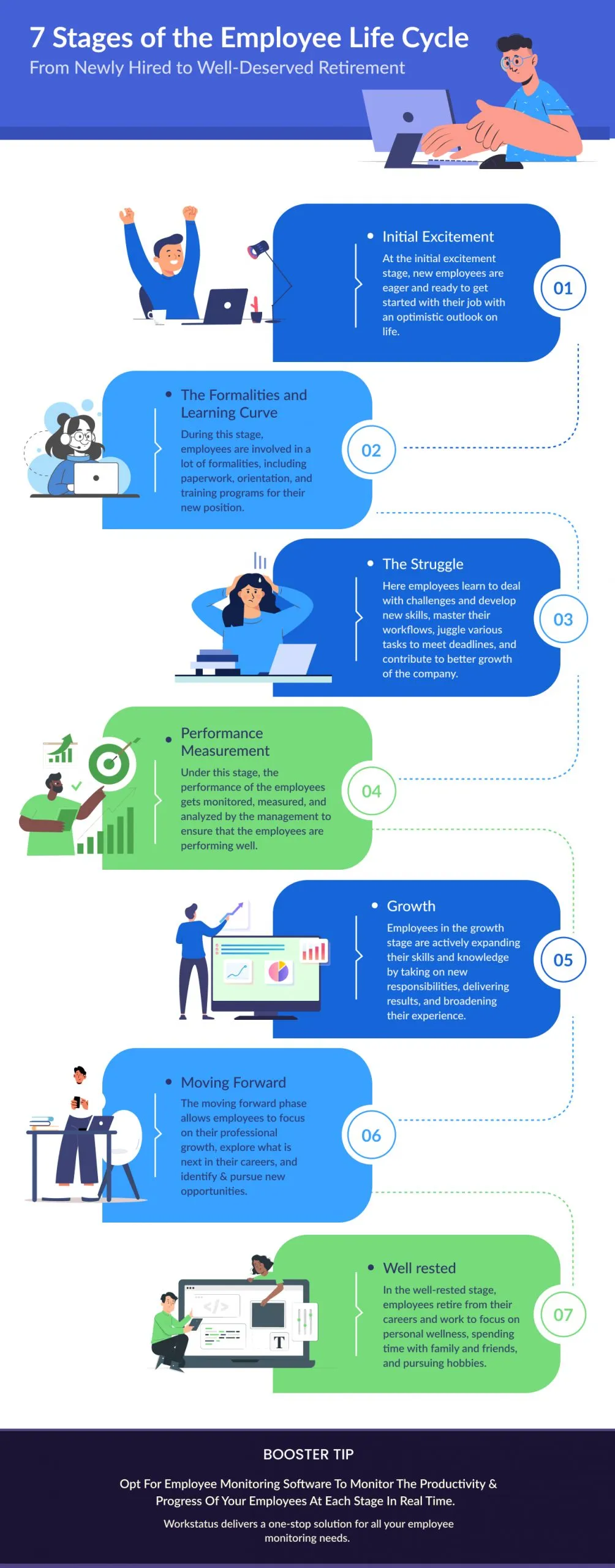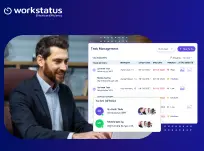Table of Contents
The employee life cycle is a concept that has developed over time to better explain how people change throughout their careers. Each phase of the employee life cycle has its challenges and benefits. Understanding where you are in your life and what to expect will help you develop an effective work strategy and prioritize your personal goals.
To get the most out of your career, it’s important to understand how to respond appropriately to each stage that comes your way. Your response to each employee’s life cycle stage will define you professionally and shape your long-term performance goals and development within the company.
With each transition comes new skills and experiences, making it important to plan and know what to expect throughout each stage of the employee life cycle.
What are the 7 Stages of Employee Life Cycle
This guide will help you navigate through all the stages of the employee life cycle so that you know what’s next in store for you personally and professionally at every level of your career. From fresh graduates to a well-deserved retirement, you can make the best use of your time in your current job and prepare yourself best for your next role.

Stage 1: Initial Excitement
When employees are first hired, there is a lot of excitement and eagerness to get started. This stage usually lasts about two weeks. Initial excitement consists of new employees getting excited about their jobs and happy with what they’re doing.
At these stages of the life cycle, employee monitoring software is also helpful because employees will be engaged in various activities to meet their deadlines. They may need an extra push or reassurance, so managers must check in with them regularly to understand how they are doing during the process.
At this stage of employee life cycle management, you can use employee wellness programs that involve rewards to motivate employees by offering prizes, vacation packages, and incentives for meeting their goals.
Stage 2: The Formalities and Learning Curve
During this stage, an employee typically completes formalities like finishing orientation and earning time off eligibility. However, their primary focus is learning new company processes, tools, and culture.
During this stage, employee absenteeism is typically low because employees are focused on completing formalities, including getting used to new company procedures and policies.
This phase in the employee life cycle also brings more interactions with co-workers. As a result, they tend to be more productive during this period than at any other point in their tenure with the company.
Moreover, the employee is still absorbing key information about the business from management, peers, and customers. That said, it’s important for managers not to overload these new hires with too much information so they can digest it effectively.
Employees in this stage of the life cycle should also be encouraged to shadow other employees for a few days to see how work gets done across different departments within the organization, allowing them to get exposure to various job roles.
Stage 3: The Struggle
The Struggle is a stage where your values and priorities get tested, and you might realize that your goals and expectations don’t match. The purpose of this stage is to test an employee’s loyalty and commitment and provide guidance through a career counselor (if/when required).
The company needs to be sure they have chosen the right person for the job before investing in them. Once you are committed and set on your decision to stay with them, it will become clear what your responsibilities are going to be.
Through this phase, employees begin to understand the culture and how their day-to-day tasks can affect others. They start taking the initiative when necessary without being asked by management. Management begins trusting employees enough to take risks while still learning on the job.
Employees may also experience some setbacks during this time, but at least they know what not to do so those mistakes won’t happen again later in their life cycle.
This struggling phase brings a lot of values and lessons for employees, allowing them to learn about the importance of work ethic, leadership skills, and teamwork which help them become future leaders for the betterment of the company.
Stage 4: Performance Measurement
It’s important to hold each employee accountable for their work and ensure they perform their best at all times. This can be done by measuring performance against the company’s goals, objectives, and standards. Companies use many tools to measure employee performance, such as Workstatus.
Employee Monitoring Software allows you to keep an eye on your employees’ attendance records and productivity levels, along with motivating them with rewards for work well done.
Performance measurement helps you track the progress of all your employees from newly hired to senior executives, which helps in increasing retention rates in the workplace and brings out the best in every employee.
By measuring the performance of your employees, you’ll know when it’s time to take corrective action. If a person is struggling with a particular task, it could mean he needs more training or resources to help him complete his tasks more efficiently. You’ll also be able to see if there is any improvement after implementing the change and whether or not further adjustments should be made.
Stage 5: Growth
Growth is the most important and difficult stage in an employee’s life cycle. Employees are eager to learn, grow, and develop skills but can sometimes feel as if they are not progressing fast enough. They may feel frustrated that their manager does not recognize or reward their hard work.
In this stage, employees should look for mentorship opportunities to build relationships with more experienced colleagues, which allow them to ask questions and offer feedback. By doing this, employees will be able to quickly grasp the expertise and values that can lead them to better future growth.
This can allow employees to gain a new perspective on how they approach a task and increase their confidence moving forward to take on bigger challenges.
Mentoring also allows employers to create networks of engaged workers who know what it takes to achieve success at the company and are committed to helping others reach these goals, too, which make each other’s lives better.
Stage 6: Moving Forward
When a company has reached a level of success that is sustainable. To continue to grow, it is time for employees to take on new challenges and new positions. These opportunities will provide more experience and skills that can be applied to other areas of life or career path.
These opportunities can provide more experience and skills that employees can apply to other parts of their life or in their careers which will lead them to an even higher level of success and stability.
Moving forward in this stage means employees should know what has worked for them and what didn’t, but most importantly, what could work better next time for the company, the team, and themselves.
By doing so, employees can come up with better solutions and strategies for the company, team, and self while ensuring they are growing.
Stage 7: Well-deserved retirement
After completing all the stages, it’s time for employees to have well-deserved retirement. They have accomplished a lot and helped the company to grow to the higher and better stages. It may be hard to walk away from a career that employees have dedicated themselves to, but it is now time to enjoy what they have built. Reflect on everything they have done in their life so far and consider the legacy that will remain after they are gone.
At this stage, companies offer incentives to employees to retire, such as pension plans. Employees also get the opportunity to share their experiences with others who are new at work or just starting, giving advice about how not to make mistakes can help those people avoid problems when they start working.
Retirement is not always easy for every employee because it means giving up their livelihood, identity, and sense of self-worth. However, most retirees agree that they are able to spend more time with family members, pursue other interests, and travel the world. For some employees, it may feel like the end of their careers, but it actually represents the beginning of another chapter of life.
Conclusion
The stages of employee life cycle are an important aspect of any business, and all stages need a certain level of attention.
Newly hired employees need guidance and feedback on their work performance as they learn how to do their job, active employees need day-to-day motivation and challenges that will keep them engaged and interested in their work, and senior employees want more stability.
Each stage is significant for different reasons and allows employees to learn new skills, grasp new experiences, and maintain a good work-life balance.
FAQs
1. During the employee life cycle, which stage is most important?
The learning and struggling phase can be the most crucial time in the employee life cycle because this is when they are making essential connections and understanding where their strengths and weaknesses lie.
This phase teaches employees how to perform at a high level, think critically, collaborate with other team members, and navigate company politics. If an employee does not learn during this period, it will become increasingly challenging to succeed as they move through the rest of the stages.
2. What does the employee cycle teach to the employees?
The employee cycle is designed to help employees take their next step in the right direction. The process of the employee cycle through the different stages helps employees know what they should be doing and prepare them for the future challenges and opportunities ahead.
3. What can employers do to support their employees through each stage in their work-life cycle?
To help the employees in different work-life cycle stages, employers can implement a program to build on employee strengths and offer support through better management. They can give specific, focused, and detailed feedback so employees can identify their strengths and weaknesses to make improvements.
That’s all for today.
We hope you liked our blog on the seven stages of the employee life cycle!
If you have any suggestions, please mention them in the comments below!
Also, don’t forget to share this post with your friends and family if you liked it!
We will get back to you soon with another blog about some other interesting topics.
Till then
Keep reading and learning
Thank You !!











